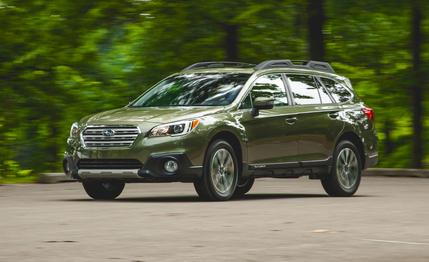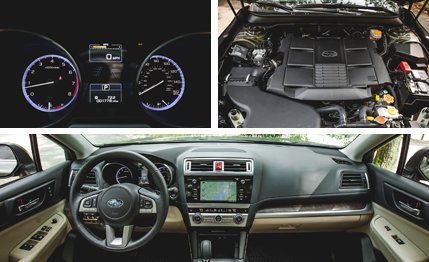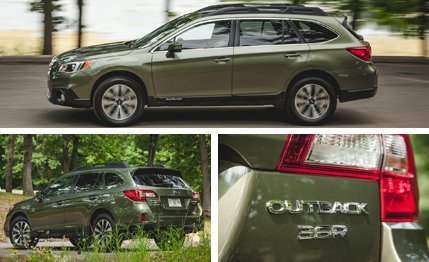
 Instrumented Test
Instrumented Test
Rather than mourn the passing of summer, why not instead embrace autumn? After all, if you live someplace with delineated seasons, fall just may be the best one for driving. Right now near our Michigan stomping grounds, for example, the leaves are changing colors, transforming roadside foliage into an explosion of reds, oranges, and yellows that encourage long, circuitous weekend tours.
Hustling a Porsche Boxster through such a landscape—top down, heater and heated seats cranked—is perhaps the ne plus ultra autumn experience. But if you need more than two seats and/or can’t bear the thought of bruising your bounty of heirloom apples in the mid-engine Porsche’s frunk, the new Subaru Outback tested here would fill the bill quite nicely. And you still get a flat-six engine.
Indeed, one of the strongest aspects of Subaru’s spacious five-seater has long been its ability to haul people and stuff with little fuss. The newest Outback’s cabin is bigger by nearly four cubic feet, and the car is 0.6 inch longer, 2.2 inches taller, and 0.7 inch wider than before. Come time for the fall harvest, farm-share carpoolers will be pleasantly surprised by the Limited model’s heated and reclining rear seats. Those folks will be able to stow numerous bushels of goodies in the 35.5-cubic-foot cargo area, which features a flat floor, handy grocery hooks, and even a 12-volt power outlet for a slow cooker full of chili. (Just be careful not to splash any sauce into the nearby subwoofer.) The sunroof is on the small side, which hinders viewing of the forest canopy overhead, but the side windows offer good visibility for all occupants. The very high driver’s seat—more than a few of us were surprised at how tall the car feels in operation—gives a commanding look at the road ahead, too.


Helping to keep safe your friends and their produce is EyeSight, which was part of our $36,835 test example’s $2990 option package that also bundles touch-screen infotainment and navigation with the sunroof, Bluetooth connectivity, passive entry, and push-button starting. EyeSight is Subaru’s term for a suite of driver-assistance features that uses stereo cameras and includes adaptive cruise control, pre-collision braking, lane-departure warning, and steering-responsive fog lights. We found the automatic braking to be effective but not annoyingly harsh or sensitive in its engagement; we still believe, however, that paying attention is the best defense against collisions. The alarm sounded by the lane-departure system is uncommonly loud and prominent, though, so it may startle your comfortable companions in the back seat.
Few folks are likely to be startled by the Outback’s performance. The tale of the tape says that the new version is better in almost every quantitative measurement compared with the previous six-cylinder Outback; 60 mph comes in 6.9 seconds (a 0.5-second improvement) and the quarter-mile is eclipsed in 15.4 at 94 mph (0.3-second quicker and 4-mph faster). However, as with its new Legacy 3.6R sibling, the latest six-cylinder Outback doesn’t feel any quicker than the old one from the seat of the pants, and our tests show that the new car is a tenth slower to reach 40 mph than was the old six-hole Outback.
Blame the feeling of sluggishness during sprints on the Outback’s new continuously variable transmission. Upon more subtle throttle inputs, the CVT does a decent job of mimicking a normal automatic (the prior 3.6-liter Outback had a conventional five-speed auto), but it’s not as good as the likes of the Honda Accord’s CVT, the best of the bunch these days. The EPA says that the new CVT six-cylinder Outback gains 3 mpg in the city and 2 on the highway over its predecessor. Our fuel mileage came out to 22 mpg, matching exactly the EPA’s combined estimate and a reasonable figure for a 3876-pound AWD crossover wagonoid.


The Subaru’s standard all-wheel drive and hill-descent control, ample suspension travel, and 8.7 inches of ground clearance help put remote vantage points easily within reach and allow it to handle serious road imperfections. That’s basically the only “handling” this car excels at, though, as it pulls only 0.79 g on the skidpad while exhibiting plenty of body roll and a fair amount of understeer. Stopping from 70 mph required a long 180 feet, too; for reference, that’s 19 feet longer than the more expensive but analogous Audi Allroad. The Subaru’s steering is fairly direct and true, although it doesn’t offer much road feel. Outback occupants—and those traversing the actual Outback—will notice the bumpiest roads, because the cabin isn’t as well insulated from wheel, tire, and suspension noise as we’d like.
All of this said, loyal Subaru customers—of which there are many—should be more than happy with the latest Outback. It builds on traditional strong suits and drives similarly to the last one. The styling is cleaner yet still familiar, crisp, and conservative. The interior has been effectively and tastefully updated yet remains clearly Subaru in design and ergonomics. The matte-finish wood trim, for example, looks a lot better than the unnaturally shiny stuff that came in the previous model.
As before, the six-cylinder Outback is available only in the top-tier Limited trim; the engine thus carries a $3000 premium over the 2.5i Limited. Lesser Outbacks start as low as $25,745. A four-cylinder model won’t hustle as hard, but neither will it cost as much. However you spec it, though, the latest Outback makes good on its promise of unpretentious capability, whatever the season.